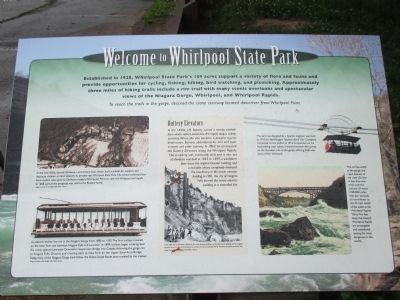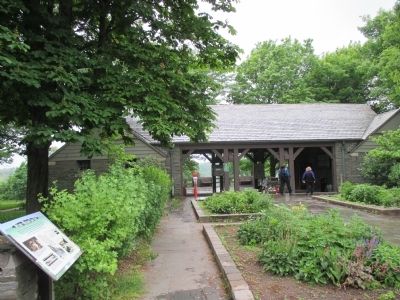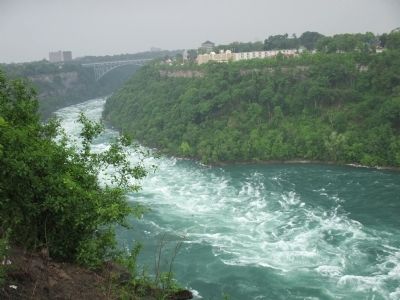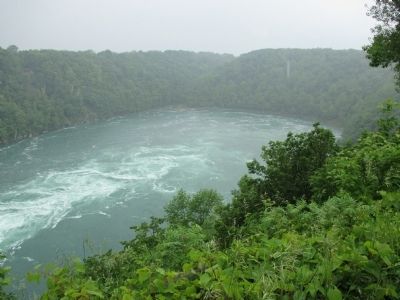Welcome to Whirlpool State Park
In the mid-1850s, Samuel DeVeaux, a prominent local citizen, built a school for orphans and destitute children on land adjacent to present-day Whirlpool State Park. The school collected fees from visitors who came to DeVeaux (today's Whirlpool) Point to view the Whirlpool and rapids. In 1858, part of the property was sold to the Buttery Family. Image courtesy of the Niagara Falls Public Library.
Buttery Elevators
In the 1850s, J. M. Buttery owned a nearby sawmill from which visitors could view the rapids atop a rickety stairway. When the site became a popular tourist destination, Buttery abandoned his mill and built a newer and safer stairway. In 1869, he constructed the Buttery Elevators along the whirlpool Rapids. The property was eventually sold and a new set of elevators was built in 1893. In 1899, a windstorm blew down the original elevator building, and a rockslide almost completely
In this 1895 view of the Buttery Elevators, the newer elevator building is on the left, and the building with the original elevators is on the right. In the foreground, workers are constructing the bed for the Great Gorge Route trolley line. Image courtesy of the Niagara Falls Public Library.
An electric trolley line ran in the Niagara Gorge from 1895 to 1935. The first trolleys traveled on the New York side between Niagara Falls and Lewiston. In 1899, trolleys began crossing over the newly opened Lewiston-Queenston Suspension Bridge into Canada, following the gorge rim to Niagara Falls, Ontario, and crossing back to New York on the Upper Steel Arch Bridge. Today, many of the Niagara Gorge trails follow the Great Gorge Route once traveled by the trolleys. Image courtesy of the Niagara Falls Public Library.
The aero car, designed by a Spanish engineer, was built in 1913 by the Niagara Spanish Aero Car Company. It opened to the public in 1916. Suspended on six interlocking steel cables, it travels between two points on the Canadian side of the gorge, offering bird's-eye views of the whirlpool.
The narrow width of the gorge, the rapid descent of the river (52 feet in less than one mile) and the volume of water (100,000
Topics. This historical marker is listed in these topic lists: Education • Entertainment • Railroads & Streetcars. A significant historical year for this entry is 1928.
Location. 43° 7.209′ N, 79° 3.858′ W. Marker is in Niagara Falls, New York, in Niagara County. Marker can be reached from Niagara Scenic Parkway (New York State Route 957A). Marker is located in Whirlpool State Park where the walkway to the front of the tourist shelter meets the parking lot. The park is accessed from the Niagara Scenic Parkway (nee: Robert Moses Parkway.). Touch for map. Marker is in this post office area: Niagara Falls NY 14303, United States of America. Touch for directions.
Other nearby markers. At least 8 other markers are within walking distance of this marker. Niagara Gorge Natural History (within shouting distance of this marker); Challenging the Whirlpool Rapids (within shouting distance of this marker); Whirlpool Rapids (about 300 feet away, measured in a direct line); Eddy Basin (about 300 feet away); Niagara Spanish Aero Car (approx. ¼ mile away in Canada); Pastimes and Parkways (approx. half a kilometer away); Whirlpool Rapids Gorge (approx. 0.6 kilometers away in Canada); Thompson Point (approx. 0.6 kilometers away in Canada). Touch for a list and map of all markers in Niagara Falls.
Also see . . .
1. Whirlpool State Park. New York State Parks, Recreation and Historic Preservation website entry:
There is no fee for the park. (Submitted on June 25, 2014, by Anton Schwarzmueller of Wilson, New York.)
2. DeVeaux School. Niagara County Historical Society website entry:
The grounds of the school are now DeVeaux Woods State Park, across the Robert Moses Parkway from Whirlpool State Park. A walkway connects the parks. (Submitted on June 25, 2014, by Anton Schwarzmueller of Wilson, New York.)
3. The Buttery Elevator. Niagara Frontier website entry (Submitted on June 25, 2014, by Anton Schwarzmueller of Wilson, New York.)
4. The Niagara Gorge Belt Line. Niagara Frontier Chapter NRHS website entry:
A pictorial album of the trolley line. (Submitted on June 25, 2014, by Anton Schwarzmueller of Wilson, New York.)
5. Whirlpool Areo Car. Wikipedia entry (Submitted on June 25, 2014, by Anton Schwarzmueller of Wilson, New York.)
Credits. This page was last revised on January 4, 2022. It was originally submitted on June 25, 2014, by Anton Schwarzmueller of Wilson, New York. This page has been viewed 789 times since then and 40 times this year. Photos: 1, 2, 3, 4. submitted on June 25, 2014, by Anton Schwarzmueller of Wilson, New York. • Bill Pfingsten was the editor who published this page.



